Introduction
The experienced dog owner knows a lot about
how to care for a dog or give a puppy a good start in life.
But for you, who maybe are just about to get your first dog ever, these chapters
might come in handy. Also for the inexperienced dog owner or if you are just
thinking about getting a dog, this will give you a fair idea of the amount work
and responsebilities that comes with owning a dog.
These chapters are part of the written pappers we give to our puppy owners and
is a complement to all verbal information that we give when we meet.
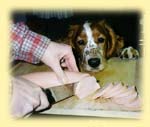 When
the puppy comes to your home at eight weeks it is probably used to eating 4
times a day. After a few month you can cut
down to 3 meals a day and at about 2 years of age cut down to 2 meals a day.
Leave out the dinner that your puppy takes the least interest in. If the puppy
has a poor appetite in the morning you can try to offer porridge, scrambled eggs
or even a cheese sandwich is better than
nothing. It is important that it eats in the mornings when it is growing. But
feed the complete food (pellets) as much as you can. It is very important as it
contains all the vitamins required. When
the puppy comes to your home at eight weeks it is probably used to eating 4
times a day. After a few month you can cut
down to 3 meals a day and at about 2 years of age cut down to 2 meals a day.
Leave out the dinner that your puppy takes the least interest in. If the puppy
has a poor appetite in the morning you can try to offer porridge, scrambled eggs
or even a cheese sandwich is better than
nothing. It is important that it eats in the mornings when it is growing. But
feed the complete food (pellets) as much as you can. It is very important as it
contains all the vitamins required.
Food type: The type of food most breeders
recommend today, is a complete food, either pellets only or pellets mixed with
meat (like Pedigree Pal). We use pellets only, make is of no greater importance
as long as it is of high quality (like Nutra Nuggets, Royal Canine, Eucanuba,
Sensible Choice, etc). The important thing is that it suits your dog. Always ask
your breeder for advise.
We never use puppy food after the puppy is six weeks old. It is often too rich
in protein and might make the puppy grow too quickly. 21-25% protein is enough.
Mix: Follow the instruction on the bag how
to prepare before serving. If the puppy is a poor eater try to serve dry
pellets, which many puppies prefer. And remember, always have fresh water in the
bowl for the puppy.
How much? At eight weeks try 1 dl dry
pellets (mixed with lukewarm water) served 4 times a day. It might not eat it
all every meal, then serve a bit less for a while so it learn not to leave some
food in the bowl every time.
Important: increase the
amount of food as the puppy is growing into a young dog. If the puppy eats it
all up, serve more next time. A puppy rarely gets too fat so make sure it never
goes hungry! A young dog of 10-15 month can eat up to 10-15 dl (dry pellets)
every day without getting fat.
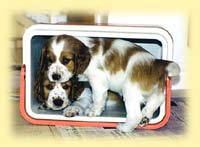 Leftovers:
can of course be added to the pellets. But beware that the puppy will get used
to titbits in the food and might not eats its pellets served on their own. Leftovers:
can of course be added to the pellets. But beware that the puppy will get used
to titbits in the food and might not eats its pellets served on their own.
If it is a poor eater one can of course mix some meat with the pellets, but only
a smaller amount, as pellets should be the main course. Unfortunately the smart
welsh springer will eat the meat and leave the pellets, so think of this before
you start adding things to the dinner. Some things like an egg yolk, some wheat
germ oil or olive oil is only good for the dog and might be added every day (egg
yolk maybe 2-3 times a week).
Do not give any extra vitamins, calcium
etc, it is all in the complete food and can make more damage than good.
Strong seasonings, bone of pork, birds or fish must never be given to the dog.
If you want to give the dog a bone, boil a big bone from cattle meat (beef).
Fresh water: always keep fresh water
available for the dog at all times and wherever you are. And if you travel
always bring a bottle of water and a bowl for your puppy.
 Back to
the top Back to
the top
Sweeties/titbits
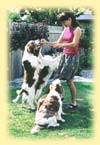 A
good encouragement when training your puppy is to sometimes give a sweetie and
every other time just a kind word and a pat. A
good encouragement when training your puppy is to sometimes give a sweetie and
every other time just a kind word and a pat.
But before giving the sweetie make sure you have eye contact with your dog and
that it is still for a little while before
running of again, or you might get a problem of the puppy just snatching the
titbit and then running off quickly.
A good sweetie to give your dog is Frolic
(rings), which are very tasty and usually loved by all dogs.
For a puppy you can cut this ring into 4 pieces, which will make it last longer
and also too much Frolic can upset the tummy on the small puppy because it is
rather rich.
Chewing bone
In the pet shop you can find good chewing bones
for your dog, made of hide. Do not bye the ones with knots in each end as the
dog can get these bits stuck in the throat. It is better with the ones only
folded up or rolled into the shape of a stick.
 Back to
the top Back to
the top
Vaccinations
We have written about this in the Swedish version
but are reluctant to make any recommendations in English as there are most
probably different "vaccination rules" for every country. So wherever you live,
ask your breeder or a vet.
De-worming
See vaccination, above. We assume that in all
countries the breeder should de-worm the litter at 3, 5 and 7 weeks of age. And
then you can do it yourself again at 11 weeks and then perhaps some once or
twice a year, just in case. In Sweden at least there is good de-worming cream to
buy at the chemist.
 Back to
the top Back to
the top
Car sickness
 If
the puppy gets sick the very first journey in the car (usually as you pick your
puppy of from your breeder) it does not mean it is going to be sick the next
time or forever. When travelling in a car with your new puppy let it sit on
somebody's lap, stroke it calmly and talk to it so that it feels secure and only
go short distances to start with. If
the puppy gets sick the very first journey in the car (usually as you pick your
puppy of from your breeder) it does not mean it is going to be sick the next
time or forever. When travelling in a car with your new puppy let it sit on
somebody's lap, stroke it calmly and talk to it so that it feels secure and only
go short distances to start with.
The sound of the engine, the smell in a car can
sometimes upset the new family member, so make sure it gets the best possible
care, especially during the first journeys. If the car-sickness continues there
are tablets to buy at the chemist or you can ask your vet. Try those for a while
and usually this problem will improve with age.
A hot car
If it is very hot (or cold) outside, let the dog
stay at home if you will have to leave it waiting in the car at some point. The
sun (even on a spring day) can quickly turn the car into a sauna and the dog
will get desperate (and can actually die) as it can not handle heat like humans
can, through sweating. Note: A narrow opening on the car window is not enough!
Tragedies of this nature happens every summer due to peoples ignorance. When you
stop for a short break on your journey, never tie your dog to the tow bar.
Safety in
the car
The best thing to save both you and
your dog if an accident should happen is for the dog to sit at the back of the
car behind a safety net (made of metal and fastened properly. This is if you
have a station wagon. If you dont and the dog is on the back seat: either use a
dog safety belt or buy a middle size cage and put it on the back seat, side ways.
Fasten it with the seat belt if possible. Make sure it stands level so the dog
can comfortably sit or lie down without sliding. Put a nice rug inside for
comfort. This way you can have a passenger on the other side in the back seat
and also the car can stay clean, without little welshie feet-marks and hair all
over the back seat.
 Back to
the top Back to
the top
Swimming and "on the boat"
Do let the puppy join you when you go to the
beach, but keep an eye on it at all times. Do not push it into the water, just
let it get used to it an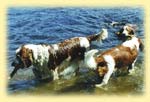 d
when it is ready it will start to swim. It might take years for some while some
will try very soon. d
when it is ready it will start to swim. It might take years for some while some
will try very soon.
Our old welsh boy "Sluggo" was 3 until he went
for his first swim and he became a very good water retriever after that and
never hesitated again. If you have a boat and want to bring your dog, always let
it wear a life jacket like the rest of the family. Don't forget that it needs to
go ashore a couple of times a day at least.
 Back to
the top Back to
the top
Care of coat
Comb or brush through the coat a couple of time a
week. Give the dog a complete bath with shampoo only when it is really dirty (or
going to a show). Use a mild dog shampoo and be very careful to rinse thoroughly.
Mind eyes and ears. Use a big bath towel to dry until it feels only slightly
damp. If it is cold outside let it get dry before you let it out. If you have
been out on a walk and it is only dirty underneath, use the shower with lukewarm
water, that is enough. Too many shampoos will only make the coat dry and dull.
Care of ears
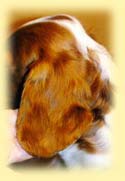
Carefully dry ears (inside) after swimming
and bathing. Cut away the coat on the inside of the ear flap (see grooming,
under "Care"). Check from time to time that the ear is healthy by using cotton
wool buds and try to go at least an inch or more down the ear, but be very very
gentle. If there is a lot of dark brown wax it does not necessarily have to be
an infection, but try to clean out with special cleanser you can by at the
chemist or in a good pet shop. But be careful so there is no fungus infection on
its way. If the dog starts to shake its head and scratch towards neck and ears,
call your vet.
 Back to
the top Back to
the top
Care
of teeth and nails
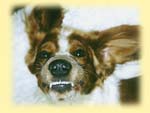 Brushing
your dogs teeth every now and again (preferably once a week) will help
preventing bad breath and tartar . Use a very small amount of ordinary
tooth-paste for fresher "kisses". Some dogs get tartar and some don't, just like
people. The easiest way to have it removed is to book an appointment with your
vet. Brushing
your dogs teeth every now and again (preferably once a week) will help
preventing bad breath and tartar . Use a very small amount of ordinary
tooth-paste for fresher "kisses". Some dogs get tartar and some don't, just like
people. The easiest way to have it removed is to book an appointment with your
vet.
Use a sharp good nail clippers and hold the
paw rock-steady. Do not cut near the pulp (you can see a pink part inside the
nail, that is the pulp). If you cut there, it is very painful and it will bleed
some, but it is not dangerous.
More about this under the chapter "Care". Cut the
nails about once every fortnight, and then take off about 2-3 mm.
 Back to
the top Back to
the top
Peace and
quiet
Any dog, but especially puppies needs to sleep a
lot without being disturbed. It is essential or it will not develop normally.
Keep the children away from the puppies bed and let the puppy wake up when it is
ready.
 Back to
the top Back to
the top
Exercise
and walks
Let the puppy play in its own pace in the garden
the first few month. You can take the car to the woods or into town for social
training (people, cars and busses). 200 meters/yards is far for a small puppy
and even if it seems like it does not mind running along it's body is not up to
it. When the puppy is about 4 month old you can take it for shorter walks round
the block. By all means take it with you wherever you go as it will get used to
seeing new thing and meeting new people and other dogs, but do not let it walk a
long time.
You can start with smaller walks (light exercise)
when the young dog is around 7 month, but even then be aware that it is still a
growing young dog.
And remember that the best way for your dog to
enjoy your "walk" is by running free, off the lead.
But always remember to be far away from roads.
The welsh is a very quick on its feet.
 Back to
the top Back to
the top
Cycling
with your dog
Do not cycle with your dog before it has reached
12 month of age. Then it might be nice to try this side of getting out with your
dog. It should be taught to trot gently by the side of the cycle. Demand
absolute obedience when cycling, for your, as well as your dogs safety. Do not
let it stop to sniff or "say hello" to other dogs. It should always run on the
inside of the cycle. When it has learned that this is pure exercise you can both
relax and enjoy it. Walk the dog for a little while and let it relieve itself
before you start the "bike-ride". Take only short rides to start with.
Never cycle with your dog off the lead!!
 Back to
the top Back to
the top
To play
with the puppy
Welsh springers are wonderful with children and
usually loves to be in the middle of everything, but some things can be good to
keep in mind. Do not let the children "stir it up" to often when indoors. If
there is piece and quiet indoors, you will find that the puppy will be very calm.
Do not let the children carry the puppy around. If they want to "cuddle" it, let
them sit down and do so. The puppy can easily and in a second leap out of the
child's arms and fall onto the floor and hurt itself.
Never leave smaller children alone to play
with the puppy, either of them may come to harm.
And remember, the puppy is not a toy!
To play with the puppy to get it tired sometimes
have the opposite effect. Let it play on its own from time to time with a
suitable toy. It does not have to be played with at all times.
Toys
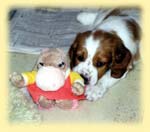 You
can give your puppy almost anything to play with as long as it is not too small
and can be swallowed, or to fragile so it can easily be broken (chewed into
small pieces). Make a double knot on an old sock or give it your old tennis
ball, they are both simple but great toys. An old teddy bear from which you
remove the plastic eyes or nose (for safety), will sure be a favourite. You
can give your puppy almost anything to play with as long as it is not too small
and can be swallowed, or to fragile so it can easily be broken (chewed into
small pieces). Make a double knot on an old sock or give it your old tennis
ball, they are both simple but great toys. An old teddy bear from which you
remove the plastic eyes or nose (for safety), will sure be a favourite.
Encourage the puppy if it is carrying things
around, remember that it is a gundog and it should like to carry/fetch and
retrieve things for you.
 Back to
the top Back to
the top
To
leave the puppy at home
The biggest problem for many new dog
owners is how to train your puppy to be on its own in the house. Do not make a
big thing out of it, make it as natural as you can.
After the puppy has settled in a few days and
feel comfortable with you, start with the following:
- Go to the dustbin with the garbage, just
casually say - Stay there, I will be back soon!
When you come in again just as casually say, hello and keep on doing what you
were about to do. You have now only been away for a minute or so. Do this
several times a day.
Usually there is always something you have to do outside that takes a minute
or two.
- Maybe you need to go to the shops to pick up
some bread and maybe be away for about 15 -30 minutes. Do that even if you
only have had the puppy for a week or so. It might object by "crying" but it
will soon get fed up and go to sleep. When you get back do not fuss with it,
just kindly say hello and do not make a big thing about coming back. If you do
the puppy will sure feel the difference of you being there and you being gone.
Then you can start staying away longer and longer until it reaches the amount
of hours you will stay away when working (no more than 5-6 hours a day).
A few things that can be helpful:
- Do not take the dog out for a walk just as you
are leaving for work.
People often think that if they have been out with the puppy just before they
leave, it must be tired and relaxed. Usually this have the opposite effect and
it will be very much awake and "on it's toes" and it will not make things
better.
- Let at least half an hours pass as you get
back from your morning walk (or play in the garden) before you leave the
house. Then the puppy has time to settle down and get a bit tired.
- Never leave it in secret.
Try to always say more or less the same words every time, which will give a
feeling of security as the puppy will know what will happen.
- If you leave the puppy naturally many times a
day even for short periods, the puppy will think it is very natural that mum/dad
come and go during the day.
- Do not forget to do the same when your whole
family have holiday and stay at home a lot. For a young dog it can be very
hard when everyone suddenly disappears again (leaving for school and work), as
the holiday is over.
- Make the puppy stay only in the kitchen (and
maybe hall) when you go.
A smaller space (and not the entire house) usually makes it more comfortable
and calm. But never shut it in a place where it is not used to staying. It
should always have a few toys maybe a chewing bone, its bed and fresh water
when left on its own. Sometimes I leave the radio on and always keep a the
lights on, if it gets dark before I get back..
 Back to
the top Back to
the top
House training
As soon as the puppy has slept, eaten or played
it usually needs to relieve itself. So try to take it up in your arms just
before you think it is about to do it. And quickly carry it out onto the lawn
and when it "goes" there, give lots of praise. Always make it understand that
you are very pleased when it does it outside. Preferably take it to more or less
the same spot every time as it will then sooner realise what you want it to do,
rather than starting to "sniff" on a new exiting place (which sometimes even can
make it forget what it was about to do).
If, or rather when, an "accident" happens indoors,
never get angry as it does not understand why. How quickly a puppy is "safe" is
more up to you than the puppy. If you are alert and take it out very often in
the beginning it usually learns quicker. If you do not feel like taking it out
often during the night, leave a morning paper (preferably "Dog World"…) on the
floor and it might just do it on that. It might take up to 6 month before it is
completely house-trained.
 Back to
the top Back to
the top
Raising a
puppy
To write a lot here about raising your puppy would take
too much space. We will give you a few ideas and then suggest to some books.
- Be consequent and distinct in your commands.
Do take your time to make sure the puppy understands what you want from it,
before you make demands. A puppy easily forgets (just like children) so do not
always expect it to remember what it knew quite well yesterday. Just be happy
and start again… Read more about this under the headline "Information" and the
chapter "About the welsh" where I write about its character.
- Check first what type of temperament your
puppy have.
Alter your voice and training accordingly. This is a typical spaniel and it is
often quite soft. Give it lots of love and encouragement and clear easy rules
and stick to those. It is just like raising children really.
Good luck!
 Back to
the top Back to
the top
Books to read
The essential welsh springer spaniel - by John
Phillips - ISBN 095 1023705
The welsh springer spaniel - by William Pferd III
- ISBN -0-498-01846-6
"The Welsh springer spaniel" by Mrs Anne
Walton, kennel Hillpark, England.
The Welsh Springer Spaniel Club Book of Champions 1902-1992 - by Welsh Springer Spanielklubben i England
(If you have read any book in your country that
you think might be suitable for the new welsh owner, please let me know and we
can ad the book to this list. Include title, author and ISBN number.
Also I need a short "review" of the book. You just send us a mail).
 Back to
the top Back to
the top
 Back Back
|